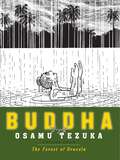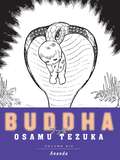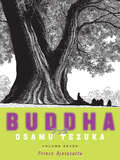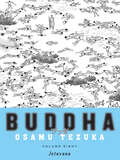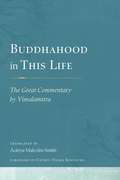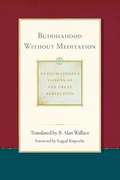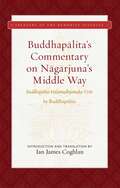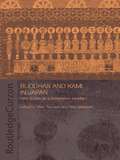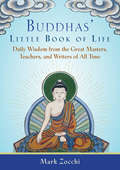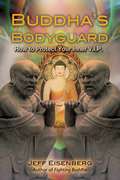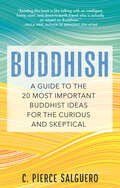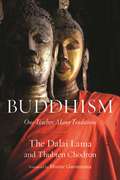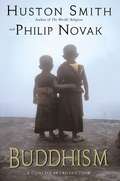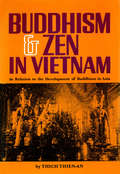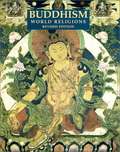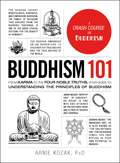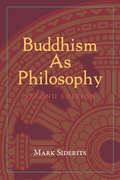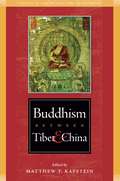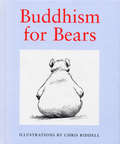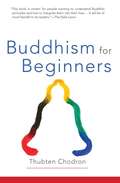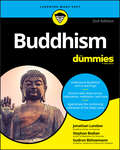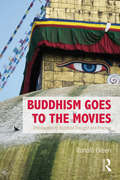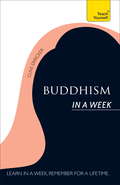- Table View
- List View
Buddha: Volume 4: The Forest of Uruvela (Buddha #4)
by Osamu TezukaThe Eisner and Harvey Winner In this fourth volume of the award-winning graphic novel biography, Buddha slowly discovers that his destiny lies in a path not readily available to him. With fellow ascetics Dhepa who has complete faith in the purifying quality of painful physical ordeals, and Assaji, who can predict everyone's death to the hour, Buddha travels through the kingdom of Magadha into the Forest of Uruvela, where The Middle Path and Enlightenment wait beyond a series of death-defying trials. Awake under the Pippala tree...
Buddha: Volume 5: Deer Park (Buddha #5)
by Osamu TezukaIn the fifth installment of manga-godfather Osamu Tezuka's Buddha, engagement with death imparts the lesson of life's sanctity. In a Machiavellian rise to power, Devadatta, a rogue aristocrat, incites war between two kingdoms that will leave thousands dead. King Bimisara of Magadha, fearing death his son's own hand, withdraws fatherly love. The true measure of the Buddha's divinity will turn out to be a test of diplomacy - the power of words.
Buddha: Volume 6: Ananda (Buddha #6)
by Osamu TezukaIn the sixth volume of manga visionary Osamu Tezuka's Buddha, the devil Mara possesses the bandit Ananda, half-brother of Devadatta, in an effort to eliminate the Buddha. A ruthless killer who is impervious to physical harm, Ananda will retain the devil's favor only if he spurns his love interest. When Ananda and his bandit buddy attack the Fire Shrine of the Brahmin brothers Kassapa, it is none other than the Awakened One who happens by. Buddha must confront his eternal enemy, Mara, before he can open the eyes of arrogant priests and hardened criminals.
Buddha: Volume 7: Prince Ajatasattu (Buddha #7)
by Osamu TezukaOsamu Tezuka's vaunted storytelling genius, consummate skill at visual expression, and warm humanity blossom fully in his eight-volume epic of Siddhartha's life and times. Tezuka evidences his profound grasp of the subject by contextualizing the Buddha's ideas; the emphasis is on movement, action, emotion, and conflict as the prince Siddhartha runs away from home, travels across India, and questions Hindu practices such as ascetic self-mutilation and caste oppression. Rather than recommend resignation and impassivity, Tezuka's Buddha predicates enlightenment upon recognizing the interconnectedness of life, having compassion for the suffering, and ordering one's life sensibly. Philosophical segments are threaded into interpersonal situations with ground-breaking visual dynamism by an artist who makes sure never to lose his readers' attention. Tezuka himself was a humanist rather than a Buddhist, and his magnum opus is not an attempt at propaganda. Hermann Hesse's novel or Bertolucci's film is comparable in this regard; in fact, Tezuka's approach is slightly irreverent in that it incorporates something that Western commentators often eschew, namely, humor.
Buddha: Volume 8: Jetavana (Buddha #8)
by Osamu TezukaOsamu Tezuka's vaunted storytelling genius, consummate skill at visual expression, and warm humanity blossom fully in his eight-volume epic of Siddhartha's life and times. Tezuka evidences his profound grasp of the subject by contextualizing the Buddha's ideas; the emphasis is on movement, action, emotion, and conflict as the prince Siddhartha runs away from home, travels across India, and questions Hindu practices such as ascetic self-mutilation and caste oppression. Rather than recommend resignation and impassivity, Tezuka's Buddha predicates enlightenment upon recognizing the interconnectedness of life, having compassion for the suffering, and ordering one's life sensibly. Philosophical segments are threaded into interpersonal situations with ground-breaking visual dynamism by an artist who makes sure never to lose his readers' attention. Tezuka himself was a humanist rather than a Buddhist, and his magnum opus is not an attempt at propaganda. Hermann Hesse's novel or Bertolucci's film is comparable in this regard; in fact, Tezuka's approach is slightly irreverent in that it incorporates something that Western commentators often eschew, namely, humor.
Buddhahood in This Life: The Great Commentary by Vimalamitra
by Malcolm Smith Chokyi Nyima RinpocheDiscover a profound text that has influenced Tibetan teachers for generations. Buddhahood in This Life is a complete translation of the earliest Tibetan commentary on the Dzogchen secret instructions.Available for the first time in English, Buddhahood in This Life presents the Great Commentary of Vimalamitra--one of the earliest and most influential texts in the Dzogchen tradition of Tibetan Buddhism. It explores the theory and practice of the Great Perfection tradition in detail, shows how Dzogchen meditation relates to the entirety of the Buddhist path, and outlines how we can understand buddhahood--and even achieve it in our lifetime. This essential text includes topics such as: · How delusion arises · The pathway of pristine consciousness · How buddhahood is present in the body · and more. Translator Malcolm Smith includes an overview, analysis and clarification for all topics. Buddhahood in This Life covers fine details of Dzogchen meditation, including profound "secret instructions" rarely discussed in most meditation manuals. This text is essential for any serious student of the Great Perfection.
Buddhahood without Meditation
by B. Alan Wallace Dudjom Lingpa Sera KhandroThe revelations of Düdjom Lingpa, a highly influential mystic of 19th century Tibet, translated by B. Alan Wallace. The practice of Dzogchen, the Great Perfection, is the pinnacle of the nine vehicles of practice taught in the Nyingma school of Tibetan Buddhism. The highly influential mystic Düdjom Lingpa (1835–1904) and his disciple Sera Khandro (1892–1940), the most prolific female writer in Tibetan history, here illuminate the methods to discover our own primordial purity and abide in uncontrived awareness. Buddhahood Without Meditation: This is Düdjom Lingpa’s most widely taught visionary text. In it wisdom beings and historical figures in the Great Perfection lineage emphasize the view of cutting through (trekchö) to the original purity of pristine awareness via the four special samayas, or pledges, of the Great Perfection: nonexistence, oneness, uniform pervasiveness, and spontaneous actualization. At each stage of his spiritual progress, Düdjom Lingpa’s doubts are dispelled and his realizations enhanced by pithy advice. The Fine Path to Liberation: Sera Khandro establishes the necessary motivation and conduct for receiving teachings such as Buddhahood Without Meditation. This sublime Dharma is to be seen in the context of the five perfections of the sambhogakaya: the teacher, place, time, disciples, and Dharma are fully perfected and must not be reified as ordinary. Garland for the Delight of the Fortunate: Sera Khandro fills in the gaps of Buddhahood Without Meditation, explaining the metaphors, and spelling out the implications of the root text’s highly condensed verses. This is an essential key for unlocking Düdjom Lingpa’s profound wisdom.
Buddhapalita's Commentary on Nagarjuna's Middle Way: Buddhapalita-Mulamadhyamaka-Vrtti (Treasury of the Buddhist Sciences)
by BuddhapalitaA masterful translation of classic scholar Buddhapalita&’s breakthrough elucidation of Nagarjuna&’s famous Middle Way text, which has profoundly influenced generations of Buddhist philosophers.This &“Buddhapalita&” commentary on Nagarjuna&’s famous first-century text Wisdom: Fundamental Middle Way Verses has been considered for over a thousand years by Indian and Tibetan philosophers to be the special key that best unlocks the deep philosophical freedom from confusion and perplexity that the Middle Way (or Centrist) school seeks to provide for its students. Chandrakirti (seventh century) defended Buddhapalita&’s elegant approach as most effective in opening the Middle Way for the inquiring mind to find the liberating experience of reality. Atisha (eleventh century) brought Buddhapalita&’s and Chandrakirti&’s transformative critical method to spread widely in Tibet, and Tsongkhapa (fifteenth century) provided a clarification of this philosophical work that was so rigorous and crystal clear that it opened the minds of Tibetan philosopher scientists of all schools until today. Ian Coghlan&’s masterful translation makes Buddhapalita&’s breakthrough elucidation of the Wisdom Verses clearly accessible. The translator&’s unique education combines the Indo-Tibetan geshé curriculum with the modern doctoral training that adds comparative text-critical analysis and comparative language research in Sanskrit as well as Tibetan. This intellectual and experiential education enabled him to produce this reliable translation for the philosophical seeker to fully engage with Buddhapalita&’s richly transformative, liberating work.
Buddhas and Kami in Japan: Honji Suijaku as a Combinatory Paradigm
by Mark Teeuwen Fabio RambelliThis volume offers a multidisciplinary approach to the combinatory tradition that dominated premodern and early modern Japanese religion, known as honji suijaku (originals and their traces). It questions received, simplified accounts of the interactions between Shinto and Japanese Buddhism, and presents a more dynamic and variegated religious world, one in which the deities' Buddhist originals and local traces did not constitute one-to-one associations, but complex combinations of multiple deities based on semiotic operations, doctrines, myths, and legends. The book's essays, all based on specific case studies, discuss the honji suijaku paradigm from a number of different perspectives, always integrating historical and doctrinal analysis with interpretive insights.
Buddhas' Little Book of Life: Daily Wisdom from the Great Masters, Teachers, and Writers of All Time
by Mark ZocchiInspired by teachings of the Buddha, great masters, teachers, and writers, this is a book designed to help people connect to their inner divinity and find their spiritual path. It is overflowing with profound quotes, sayings, and insights, each presented on its own to allow the reader to dip in randomly and consider one insight at a time. Each reading is guaranteed to immediately inspire or provide food for thought. <P><P>The quotations and sayings have been chosen from Gautama Buddha and other masters of spirituality and inspiration, such as Milarepa, Longchenpa, his Holiness the 14th Dalai Lama, Thich Nhat Hanh, Sogyal Rinpoche, and other greats such as Cicero, Rumi, Lao Tzu, Mother Teresa, and Shakespeare. <P><P>This book is designed to live on your desk, coffee table, or nightstand to provide you with daily comfort, wisdom, and spiritual nourishment. <P><P>“When my house burned down, I gained an unobstructed view of the moon.” —Zen <P><P>“There is no master, there is no instructor, there is no person to tell you what you must do.” —Krishnamurti <P><P>“To abandon what is harmful To adopt what is wholesome To purify the heart and mind: This is the teaching of the Buddha.” —Buddha
Buddha’s Bodyguard: How to Protect Your Inner V.I.P.
by Jeff EisenbergAn innovative guide to applying the strategies of a bodyguard to create a Buddhist “security plan” for protecting ourselves from suffering • Presents the unique concept of the “bodyguard” and its protection tactics as a metaphor for explaining and implementing Buddhist teachings • Recasts the Four Noble Truths as the Four Noble Tactical Truths, the Eightfold Path as the Eight Tactics Plan, and the notion of Interbeing in the Buddhist world as the Tactics of Interdepending • Offers a new, modern understanding for the new generation of Buddhist practitioners intrigued by a more Western take on Buddhism Drawing from his extensive experience as a professional protection agent, Jeff Eisenberg uses the tactics and strategies that a bodyguard employs in protecting a client from a threat as a blueprint for creating a Buddhist “security plan.” This plan provides the practical tools to protect one’s self from the threat of suffering in our world. Using the metaphor of being the Buddha’s bodyguard to understand the Buddhist teachings, the book details how to protect our inner “Buddha nature” and secure our mental and emotional wellbeing. We all have the chance to train ourselves to be more proactive in our own safety and avoid becoming a victim. And if we are victimized, this training will prepare us to take appropriate actions that will aid in our ability to survive with much less injury and trauma. As the author affirms: “It is vital to realize that a physical altercation is the last thing that happens in a chain of events. And while we must never blame the victim, our safety is our responsibility. Many situations can be avoided, or their severity greatly lessened, if we pay attention during the chain of events that leads up to it and respond appropriately.” While this book is not about personal protection per se, it applies personal protection theory and specific tactics utilized by bodyguards to Buddhist practice, laying out strategies to protect our inner Buddha from attack. Thus the Four Noble Truths are applied to the concept of “threat” in the form of Four Noble Tactical Truths, the Eight Tactics Plan echoes the Eightfold Path, and the Tactics of Interdepending embrace the notion of Interbeing in the Buddhist world. With “paying attention” and mindfulness being key concepts of both a bodyguard’s profession and Buddhist practice, this pioneering book speaks to Buddhists and non-Buddhists alike.
Buddhish: A Guide to the 20 Most Important Buddhist Ideas for the Curious and Skeptical (Encounters With Asia Ser.)
by C. Pierce SalgueroAn engaging, accessible introduction to Buddhism for those who are looking to explore a new spiritual tradition or understand the roots of their mindfulness practice.Are you curious about Buddhism but find yourself met with scholarly texts or high-minded moralizing every time you try to pick up a book about it? Well, if so, relax. This is no ordinary introduction to Buddhism; there are none of the saccharine platitudes and dense pontification that you may have come to expect. Buddhish is a readable introduction for complete newcomers that provides an objective, streamlined overview of the tradition – from unpacking the Four Noble Truths to understanding what &“nirvana&” actually means. For those who have already dipped their toes into the tradition through the practice of mindfulness or meditation, this guide will help you create a more well-rounded and informed experience by delving into the history of the Buddhist traditions that shape a mindful practice. Buddhist scholar Dr. Pierce Salguero analyzes the ideas and philosophy of the complex tradition through the eyes of both a critic and an admirer. He shares anecdotes from his time at a Thai monastery, stories from the years he spent living throughout Asia, and other personal experiences that have shaped his study of Buddhism. Through this guide, readers will have the opportunity to develop an approach to practice that is not quite Buddhist but Buddhish. Through engaging and lighthearted stories, Dr. Salguero breaks down 20 central principles of the tradition, including: • Awakening • Suffering • Doubt • Karma • Buddha Nature
Buddhism
by Thubten Chodron His Holiness the Dalai Lama Bhante Henepola GunaratanaExplore the common ground underlying the diverse expressions of the Buddha's teachings with two of Tibetan Buddhism's bestselling authors.Buddhism is practiced by hundreds of millions of people worldwide, from Tibetan caves to Tokyo temples to redwood retreats. To an outside viewer, it might be hard to see what they all have in common. In Buddhism, His Holiness the Dalai Lama and American Buddhist nun Thubten Chodron map out with clarity the convergences and the divergences between the two major strains of Buddhism--the Mahayana traditions of Central and East Asia and the Theravada traditions of South and Southeast Asia. Especially deep consideration is given to the foundational Indian traditions and their respective treatment of such central tenets as the four noble truths the practice of meditation the meaning of nirvana enlightenment. The authors seek harmony and greater understanding among Buddhist traditions worldwide, illuminating the rich benefits of respectful dialogue and the many ways that Buddhists of all stripes share a common heritage and common goals.
Buddhism
by Huston Smith Philip NovakA concise and up-to-date guide to the history, teachings, and practice of Buddhism by two luminaries in the field of world religions.
Buddhism & Zen in Vietnam
by Thich Thien-AnBuddhism & Zen in Vietnam provides, for Western readers, a much needed introduction to this important religion-its history, practices, concepts, and role in the lives of the people, the nation, and Vietnamese culture.
Buddhism (Revised edition)
by Madhu Bazaz WanguBuddhism, Revised Edition presents the full history and development of this religion, including its origins, growth, and spread throughout Asia; the evolution of its three major schools of thought; and the essence of its philosophy and precepts. New coverage includes: - The ""socially engaged Buddhist" who works with the poor, the homeless,the addicted, the dying, and the incarcerated - How scholars are examining Buddhist teachings in light of modern-day problems,including the environment, human rights, and medical ethics - The growth and practice of Buddhism in America - The current situation of Buddhist countries under Communist rule - The Dalai Lama's continuing struggle to lead his followers while in exile.
Buddhism 101: From Karma to the Four Noble Truths, Your Guide to Understanding the Principles of Buddhism
by Arnie KozakA Simon & Schuster eBook. Simon & Schuster has a great book for every reader.
Buddhism As Philosophy
by Mark SideritsIn Buddhism As Philosophy, Mark Siderits makes the Buddhist philosophical tradition accessible to a Western audience. Offering generous selections from the canonical Buddhist texts and providing an engaging, analytical introduction to the fundamental tenets of Buddhist thought, this revised, expanded, and updated edition builds on the success of the first edition in clarifying the basic concepts and arguments of the Buddhist philosophers.
Buddhism Between Tibet and China
by Matthew KapsteinExploring the long history of cultural exchange between 'the Roof of the World' and 'the Middle Kingdom,' Buddhism Between Tibet and China features a collection of noteworthy essays that probe the nature of their relationship, spanning from the Tang Dynasty (618 - 907 CE) to the present day. Annotated and contextualized by noted scholar Matthew Kapstein and others, the historical accounts that comprise this volume display the rich dialogue between Tibet and China in the areas of scholarship, the fine arts, politics, philosophy, and religion. This thoughtful book provides insight into the surprisingly complex history behind the relationship from a variety of geographical regions. Includes contributions from Rob Linrothe, Karl Debreczeny, Elliot Sperling, Paul Nietupski, Carmen Meinert, Gray Tuttle, Zhihua Yao, Ester Bianchi, Fabienne Jagou, Abraham Zablocki, and Matthew Kapstein.
Buddhism For Bears
by Chris RiddellBears are seriously underestimated creatures when it comes to spirituality and religious feeling. For the first time, this book recognises their huge potential and offers ursine students of Buddhism everywhere the opportunity to focus their skills and follow the path to enlightenment. From the meditation to the essential concepts of Zen, all the fundamentals are set out here in a series of concise interpretations of Buddhist teaching. Wonderfully illustrated by well-known illustrator Chris Riddell, this is the perfect gift with a difference.
Buddhism For Beginners
by Thubten Chodron"This book is designed for people who are interested in Buddhism as well as those who have studied or practiced it for years but are still unclear about some points. The way some of the initial material on Buddhism was translated in the West decades ago has led to misinterpretations even among those who teach Buddhism at the high school and college levels. I hope that this book will help those teachers and their students. You can read this book from cover to cover or go directly to the sections that interest you. This book is not designed to be a comprehensive introduction to Buddhism, but to clarify points, provide Buddhist perspectives on modern issues, and stimulate the curiosity and questioning minds of the readers."
Buddhism For Dummies: 2nd Edition (For Dummies)
by Jonathan Landaw Stephan Bodian Gudrun BühnemannYour hands-on guide to this widely practiced and ancient religion Buddhism, one of the world's most widely practiced religions, is a fascinating yet complex eastern religion that is rapidly spreading throughout western civilization. What does it mean to be a Buddhist? What are the fundamental beliefs and history behind this religion? Buddhism For Dummies explores these questions and more in this updated guide to Buddhist culture. You'll gain an understanding of the origins of this ancient practice and how they're currently applied to everyday life. Whether you're a searcher of truth, a student of religions, or just curious about what makes Buddhism such a widely practiced religion, this guide is for you. In plain English, it defines the important terms, explains the key concepts, and explores in-depth a wide range of fascinating topics. New and expanded coverage on all the schools of Buddhism, including Theravada, Tibetan, and Mahayana The continuing relevance of the Dalai Lama Updated coverage on daily observances, celebrations, styles, practices, meditation, and more Continuing the Dummies tradition of making the world's religions engaging and accessible to everyone, Buddhism For Dummies is your essential guide to this fascinating religion. Buddhism For Dummies (9781119643265) was previously published as Buddhism For Dummies (9781118023792). While this version features a new Dummies cover and design, the content is the same as the prior release and should not be considered a new or updated product.
Buddhism Goes to the Movies: Introduction to Buddhist Thought and Practice
by Ronald GreenBuddhism Goes to the Movies: Introduction to Buddhist Thought and Practice explains the basics of Buddhist philosophy and practice through a number of dramatic films from around the world. This book introduces readers in a dynamic way to the major traditions of Buddhism: the Theravāda, and various interrelated Mahāyāna divisions including Zen, Pure Land and Tantric Buddhism. Students can use Ronald Green’s book to gain insights into classic Buddhist themes, including Buddhist awakening, the importance of the theory of dependent origination, the notion of no-self, and Buddhist ideas about life, death and why we are here. Contemporary developments are also explored, including the Socially Engaged Buddhism demonstrated by such figures as the Dalai Lama, Thich Nhat Hanh, Aung San Suu Kyi, and other Buddhist activists. Finally, comparisons between filmic expressions of Buddhism and more traditional artistic expressions of Buddhism—such as mandala drawings—are also drawn. An important addition to any introduction to Buddhist philosophy and practice, Buddhism Goes to the Movies is an excellent way to bring Buddhist thought, history, and activity to the uninitiated and interested reader.
Buddhism In A Week: Teach Yourself
by Clive ErrickerLearn in a week, remember for a lifetime!In just one week, this accessible book will give you knowledge to last forever. End of chapter summaries and multiple choice questions are all designed to help you test your knowledge and gain confidence. So whether you are a student or you simply want to widen your knowledge, you will find this seven-day course a very memorable introduction.Sunday: Consider what Buddhism is and why it mattersMonday: Learn who the Buddha was and how he livedTuesday: Examine the Buddha's teaching on a wide range of issuesWednesday: Discover the Buddhist scriptures and learn how they are interpreted today.Thursday: Explore meditation and Buddhist devotional practices.Friday: Engage with the ethics of Buddhism, and how Buddhists respond to moral issuesSaturday: Clarify procedures for disciplinary interviews
Buddhism In A Week: Teach Yourself
by Clive ErrickerLearn in a week, remember for a lifetime!In just one week, this accessible book will give you knowledge to last forever. End of chapter summaries and multiple choice questions are all designed to help you test your knowledge and gain confidence. So whether you are a student or you simply want to widen your knowledge, you will find this seven-day course a very memorable introduction.Sunday: Consider what Buddhism is and why it mattersMonday: Learn who the Buddha was and how he livedTuesday: Examine the Buddha's teaching on a wide range of issuesWednesday: Discover the Buddhist scriptures and learn how they are interpreted today.Thursday: Explore meditation and Buddhist devotional practices.Friday: Engage with the ethics of Buddhism, and how Buddhists respond to moral issuesSaturday: Clarify procedures for disciplinary interviews
